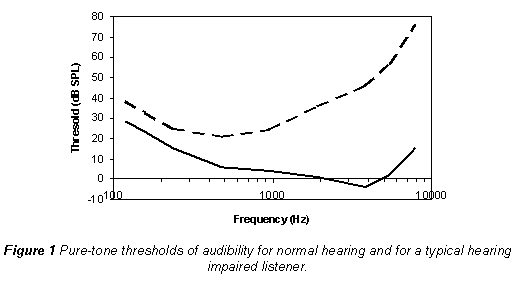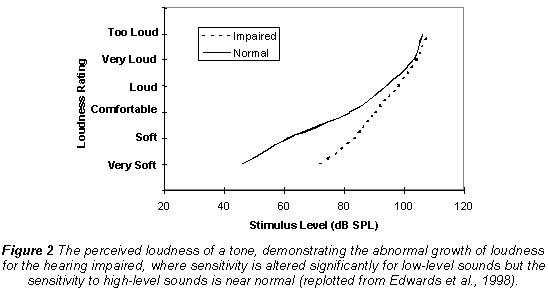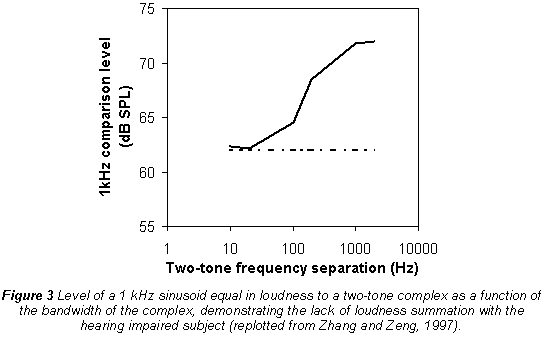Sensorineural hearing impairment alters sound perception in a complex nonlinear manner. The relative amplitudes of harmonics and temporal modulations are among the many characteristics of sound that are altered, resulting in distorted percepts such as timbre and loudness. These changes to the perception of sound due to hearing impairment affect both speech intelligibility and sound quality. With knowledge of these detriments, signal processing can be designed to compensate for specific psychoacoustic aspects of sensorineural hearing impairment and return sound perception to a more normal-like state. This paper details the primary distortions to auditory perception experienced by the hearing impaired.
Hearing impairment and Sound ID Processing:
There are four main characteristics of sensorineural hearing impairment: reduced sensitivity, abnormal growth of loudness, reduced frequency selectivity and reduced temporal resolution. These characteristics are frequency-varying and are dependent on the frequency-specific nature of an individual's hearing impairment.
Sophisticated digital models of nonlinear cochlear mechanics and neural tuning describe the auditory system and how the system changes with hearing impairment. These models provide a framework for signal processing techniques critical to the compensation of sensorineural hearing impairment. By implementing a digital representation of the cochlea on an audio product, the product can apply normal cochlear processing to the sound that the damaged auditory system can no longer provide, and the hearing-impaired user will perceive the processed sound in a more normal manner. In order to fit the processing to the hearing of the listener, how the listener's hearing differs from normal must be understand at a basic psychoacoustic level.
Psychoacoustic thresholds from a variety of hearing tests are shown in the following figures for both normally-hearing subjects (solid lines) and hearing-impaired subjects (dashed lines), demonstrating several characteristics of hearing impairment. The differences between the thresholds for the normal and impaired subjects provide a scientific basis for understanding the difficulty that hearing-impaired listeners have with the perception of sound. These differences can also lead to the design of the signal processing that compensates for such impairment.
1- Sensitivity
Figure 1 shows the threshold of detection for pure tones, below which sounds cannot be perceived (plotted in dB SPL instead of the more traditional dB HL). The threshold curve for a typical hearing-impaired subject demonstrates that hearing impairment is more prevalent in the high frequency region. This typical loss of audibility can cause high frequency speech sounds to become imperceptible. Because most consonants are at higher frequencies and lower levels than vowels, and because consonants carry most of the information in speech, the hearing impaired have significant difficulty with speech understanding. This is particularly true in noisy situations, but for other reasons described below.

2- Nonlinear Loudness Shift
Figure 2 demonstrates the change to loudness perception caused by sensorineural hearing impairment. With this psychoacoustic test, a listener is presented with tones or narrowband noise at different sound pressure levels and is asked to judge the loudness using a predefined scale. High level sounds are typically judged to have the same loudness by the hearing impaired and normal listener. Sounds at lower levels, however, are judged to be softer by the hearing impaired than by the normally-hearing. This nonlinear shift in loudness varies with level and frequency and is one indication of the level of sophistication necessary to restore auditory perception to normal for hearing-impaired listeners and why compression is an important part of this compensation.

The difference in loudness perception between the normally-hearing and the hearing-impaired also varies with bandwidth of the signal. Figure 3 plots the perceived loudness of a 63-dB SPL two-tone complex as the bandwidth changes. The perceived loudness is plotted as the comparison level of a 1 kHz tone, so the ordinal units are phones. For a normal hearing listener, the loudness of a sound increases as the bandwidth of the signal increases, even if the signal power doesn't change. This is called loudness summation. For a listener with no healthy outer hair cells, this increase in loudness with bandwidth does not occur; the flat line in Figure 3 shows that loudness remains the same regardless of the bandwidth. Loudness summation has been lost with this hearing impaired listener.
The difference between these two curves is a result of the way that sound is filtered into separate channels along the basilar membrane inside the cochlea; the combination of a multichannel filterbank and compression in the cochlea results in this phenomenon. In order to correct for this bandwidth deficit, signal processing compensation must use compression and a filterbank of the same design as in the cochlea. If not, loudness perception of narrowband and broadband sounds cannot be perceived properly with a single signal processing solution.

3- Frequency Resolution
The ability of the ear to resolve sound components of different frequencies is an important aspect of speech perception and hearing in general. If the frequency resolving capability is compromised, then formants may become more difficult to identify, impairing the ability to understand speech. Background noise would worsen this ability as the ear becomes less able to separate the masking noise from the target speech.
Figure 4 illustrates how frequency resolution is affected by sensorineural hearing impairment. The curves plot the threshold of detection for a tone in the presence of a 1 kHz masker. The broadening of the elevated thresholds indicates that impaired auditory system is less able to resolve the target tone from the masking tone, presumably due to broadening of the impaired listener's auditory filters. The wider filter bandwidths do not separate the different frequency regions as well are narrower ones. The result is a smeared spectral representation of sound in the impaired auditory system. Few signal processing solutions have been designed to address this problem.

4- Temporal Resolution
The cochlea is a dynamic system that operates on the auditory signal in a nonlinear and time-varying manner. The specific dynamics have an impact on how brief sounds—transients in music, consonants in speech—are perceived and can affect our ability to hear them over competing background noise or simultaneous instruments. The temporal envelope of speech, which codes significant information, is distorted by an impaired auditory system, resulting in distorted speech perception.
The temporal resolution capabilities of a listener can be measured with a forward masking paradigm that measures the listener's ability to hear a brief signal that follows a longer and higher-level masking sound. The solid line in Figure 5 plots a normally-hearing listener's ability to hear such a brief signal, plotted as a function of the time after the louder masking sound. The curve indicates that the signal is easier to hear as the time separation between the masker and the signal increases and is an indication of the effective time constants associated with normal hearing. The dashed line indicates the performance for someone with hearing impairment, demonstrating a more difficult time hearing the signal. The change in decay rate of the curve indicates a difference in the dynamics of the impaired ear processing. Poorer temporal processing ability affects the many aspects of perception, and has been blamed for the poorer ability to discriminate between plosives and fricatives by the hearing impaired. These changes to the temporal resolving capabilities must be accounted for when compensating for the deficits of the hearing impaired.

Conclusions:
The perceptual consequences of sensorineural hearing loss are complex and go far beyond reduced sensitivity represented by an audiogram. Temporal and spectral aspects of auditory perception are affected such that thresholds from a wide variety of psychoacoustic measures deviate from normal-like performance. Understanding the way in which hearing is affected can lead to improved signal processing algorithms that attempt to normalize auditory perception at the basic psychoacoustic level (Edwards, 2001; Edwards, 2002).
References:
B. Edwards, C. Struck, P. Dharan and Z. Hou (1998). ''New Digital Processor for Hearing Loss Compensation Based on the Auditory System,'' Hear. Jour. 51(8): 38-49.
B. Edwards (2001). ''Application of Psychoacoustics to Audio Signal Processing,'' IEEE SSC-2001, vol. 1, pp. 814-818.
B. Edwards (2002). ''Signal Processing, Hearing Aid Design, and the Psychoacoustic Turing Test,'' IEEE ICASSP-2002, vol. 4, pp. 3996-3999.
C. Zhang and F-G. Zeng (1997). ''Loudness of Dynamic Stimuli in Acoustic and Electrical Hearing,'' J. Acoust. Soc. Am., vol. 102, pp. 2925-2934.
M. Florentine, S. Buus, B. Scharf and E. Zwicker (1980). ''Frequency Selectivity in Normally-Hearing and Hearing-Impaired Observers,'' J. Speech Hear. Res., vol. 23, pp. 646-669.

